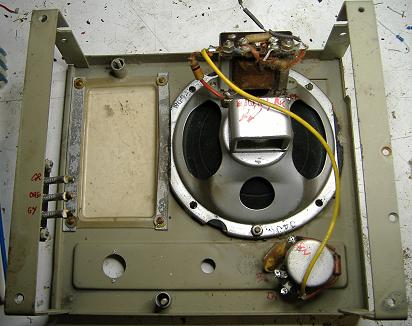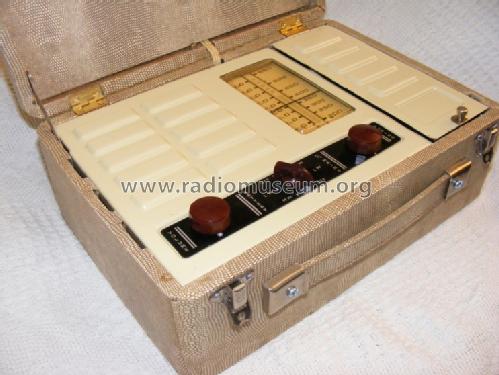Attache CN396A
Vidor Ltd.; Erith (Kent)
- Land
- Grossbritannien (UK)
- Hersteller / Marke
- Vidor Ltd.; Erith (Kent)
- Jahr
- 1950
- Kategorie
- Rundfunkempfänger (Radio - oder Tuner nach WW2)
- Radiomuseum.org ID
- 74149
Klicken Sie auf den Schaltplanausschnitt, um diesen kostenlos als Dokument anzufordern.
- Anzahl Röhren
- 5
- Hauptprinzip
- Superhet allgemein; ZF/IF 456 kHz; 1 NF-Stufe(n)
- Anzahl Kreise
- 6 Kreis(e) AM
- Wellenbereiche
- Langwelle, Mittelwelle (LW+MW).
- Betriebsart / Volt
- Netz- / Batteriespeisung / 200-250 / 7.5 & 90 Volt
- Lautsprecher
- Dynamischer LS, keine Erregerspule (permanentdynamisch) / Ø 11 cm = 4.3 inch
- Belastbarkeit / Leistung
- 2 W (Qualität unbekannt)
- Material
- Leder / Stoff / Plastic / Segeltuch über div. Material
- von Radiomuseum.org
- Modell: Attache CN396A - Vidor Ltd.; Erith Kent
- Form
- Reisegerät > 20 cm (netzunabhängig betreibbar)
- Abmessungen (BHT)
- 290 x 200 x 110 mm / 11.4 x 7.9 x 4.3 inch
- Bemerkung
- Three voltage tapping adjustments. Model CN396 has 2 tappings, otherwise almost identical.
- Originalpreis
- 215.00 Nlg
- Schaltungsnachweis
- Radio and TV Servicing books (R&TVS) book
- Literatur/Schema (1)
- -- Schematic (Trader Sheet 981.)
- Autor
- Modellseite von Karel De Reus † angelegt. Siehe bei "Änderungsvorschlag" für weitere Mitarbeit.
- Weitere Modelle
-
Hier finden Sie 146 Modelle, davon 79 mit Bildern und 75 mit Schaltbildern.
Alle gelisteten Radios usw. von Vidor Ltd.; Erith (Kent)
Sammlungen
Das Modell Attache befindet sich in den Sammlungen folgender Mitglieder.
Forumsbeiträge zum Modell: Vidor Ltd.; Erith: Attache CN396A
Threads: 2 | Posts: 3
Mine has 1R5 (RCA USA), 1T4 (RCA USA), 1S5 (Emerson USA) and DL94(Mullard) rather than the DK91, DF91, DAF91 and DL94.
Are the US tubes imports used as replacements after sale, or Factory alternate sources?
The maker label is very clear on the 1R5 but the actual "1R5" is missing. I notice on the 1T4 that the "1T4" is different much fainter ink than the "RCA made in USA".
Michael Watterson, 05.Dec.11
This only applies to the 396A, not the 396.
First take off inner cover on lid hiding loop aerial and unsolder 3 wires, identifying them for reconnection. (three colours of nail varnish on wire and terminals?)
There are FOUR fastenings to remove!
1) Remove 2x thumb nuts visible on frame at edge of battery compartment.
2) Unscrew 2 x metal feet (which are disguised bolts) at opposite side.
3) Push Chassis toward battery space to unhook frame from the two studs at side of battery compartment.
The Chassis will not lift out far:

4) 2 x clip on wires to springs at side. This is the alarm if lid is closed while on.
5) You did disconnect and identify aerial connections?
There is a mix of wire types:
1) "cab tyre rubber" wire like from 1920s & 1930s style. It may have perished.
2) "plastic". Should be OK
3) Sleeves like fibre glass, but smooth and coloured (I don't know what it is). Should be OK.
Further removal of the two sub chassis is needed usually.
To clean/repair speaker, replace wires or capacitors.
To remove Mains chassis

1) note colours of the three mains taps and cut/unsolder at "tap" connector
2) cut/remove wire from two wire-wound resistors just above transformer at power/band switch noting location. (LT?)
3) unscrew mains cable clamp
4) cut / remove wire from transformer to switch (blue on mine), note/mark location. (Mains in)
5) cut/remove wire at base of 40/40uF cap and 2k7 resistor (HT to set), leaving other end of it on the switch).
6) unscrew 2 screws at 2 x sides and two smaller screws at base of transformer at middle of end chassis bar. (6 total).
7) slide PSU out side end of chassis.

Note that the 7.5V +LT is "dropped down" from the "90V" HT line on Mains operation. 50ma Series chain with 1.2K & 700 Ohms in series. Replacement of the Dx91 series + DL94 with Dx96 series would need an increased series resistor.
Remove Radio Chassis next

(note Green/Orange/grey wires, mains taps, need removed first)
1) undo 3 x chassis nuts.
2) mark and note wires to volume control and remove (or unbolt control)
3) Mark and note wires to o/p transformer and remove.
4) Lift chassis off.

The loudspeaker can now be unbolted and/or dial plastic cleaned.

Don't lose the 3 x spacers!
(You can see one spot welded pillar came off, it can be epoxied on)
The loudspeaker may need some attention!

If the plastic dial cover is very distorted it can be straightend after warming gently with a desk lamp. But clean completely first. Gently heating with a heat gun or grill and pressing on a hard surface can remove scratches or distortion, but it would be easy to distort it more.
Michael Watterson, 27.Nov.11






























